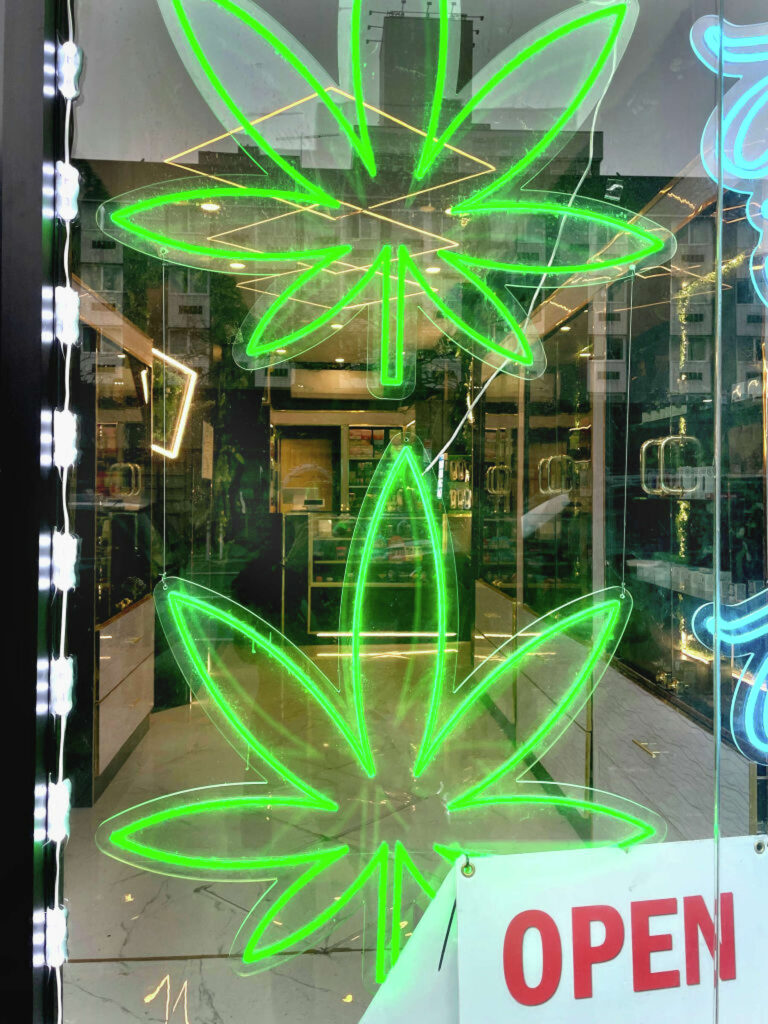Green neon cannabis leaves and an “open” sign are seen in the window of an unlicensed smoke shop selling marijuana in New York City.
Walk down the street in Manhattan and you’ll be bombarded by illicit cannabis shops with neon signs. You’ll see sidewalk signs and even product displays through their large glass windows. They look fun and inviting, and they bring a certain vibrancy to the neighborhood. When you walk inside, you find products with brands that look similar to those you might see on the labels of any microbrewery — they stand out, they are playful, and they tell a story.
While walking down that same block, you’ll probably skip right past the legal dispensary.
With its clouded or blacked-out windows and limited signage, you might think it’s a shuttered storefront. If you’re brave enough to venture inside, you’ll find branding with limited, muted color usage that looks like it was developed by someone working on a DOS-powered computer from the 1980s.
That hard-to-notice dispensary with its dimly branded products is part of a legal market that’s losing the proximity battle that’s key to winning over consumers.
The budget recently enacted by Gov. Kathy Hochul and the state Legislature made great progress in righting the listing ship that is New York’s legal cannabis industry, and we were proud to collaborate with them and our dispensary partners to help get it right. But there’s far more to do to get it on the right course. As lawmakers work through the remaining weeks of the legislative session in Albany, they must continue their work to advance New York’s legal market with changes to the marketing and advertising rules that will help our legal shops and brands compete.
Advertising and marketing rules should be overhauled to allow space for the creativity we see in every other industry, and specifically aligned with those allowed in the alcohol industry. We all agree that advertising to youth shouldn’t be allowed, but there’s no reason we can’t create branding rules that allow for creativity rather than the current, overly broad requirement that brands can’t use imagery “commonly associated with youth culture.”
We also must take our legal dispensaries out of the dark, allow them to have see-through windows like any other business, and place signage to make sure customers know they exist.
Lastly, we must let dispensary owners determine the proximity in which they can operate and still make a buck. A 2022 study in Canada found that consumers were more likely to buy legal if they live very close to a legal shop, defined as less than 2 miles. Under New York’s current rules, legal dispensaries must be at least .2 miles apart. But if the illicit market shows us anything — illicit shops in some neighborhoods are open on practically every corner — it’s that there’s ample room for retailers to open and prosper as neighbors. And until the illegal shops get closed down, their proliferation means an illicit store will almost always be closer to consumers than a legal one.
Without further action, New York’s legal adult-use cannabis market will continue to struggle to get on course. And we will lose the opportunity to offset even some of the harms caused by the decades of disproportionate, overpolicing of prohibition.
H/T: www.timesunion.com



